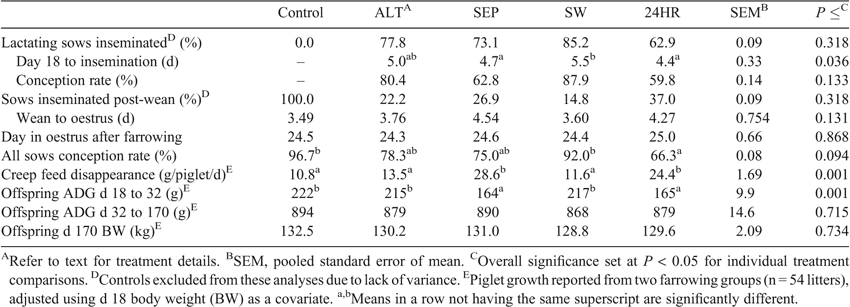A comparison of suckling reduction strategies along with boar exposure to induce oestrus in lactating sows
H. L. Frobose A B , M. D. Tokach A , J. M. DeRouchey A , S. S. Dritz A , R. D. Goodband A , J. L. Nelssen A and D. L. Davis AA Kansas State University, Manhattan, KS 66506.
B Corresponding author. Email: frobose@ksu.edu
Animal Production Science 55(12) 1502-1502 https://doi.org/10.1071/ANv55n12Ab113
Published: 11 November 2015
Breeding sows during late lactation offers pig producers the potential to uncouple weaning from re-mating. Recent research (Frobose et al. 2013; Terry et al. 2014) demonstrated that combining boar exposure and reduced suckling allowed lactational oestrus and fertility comparable to conventionally weaned sows. However, questions remain about the most practical method to apply treatments on farms. The objective of this study was to prove the hypothesis that different suckling reduction strategies will vary in the incidence of lactational oestrus and result in different effects on sow fertility and piglet growth.
A total of 135 sows (PIC 1050), from parity one to five (2.6 ± 1.4; mean ± SD), was used in five consecutive farrowing groups (Feb to Aug). Litter size was equalised by parity (11.5 ± 1.1 piglets; mean ± SD) at d 2 after farrowing. At d 18, sows were assigned to one of five treatments (n = 26 to 28) based on parity, farrowing date, and suckled litter size. Treatments were: Control; ALT (sows placed in adjacent pairs, on d 18 all but the five lightest piglets were weaned and remaining piglets combined and alternated between sows at 12 h intervals from d 18 to 25; SEP (piglets separated for 12 h/day from d 18 to 25); Split-wean (SW; all but the five lightest piglets weaned on d 18); and 24HR (piglets separated from sows for 24 h on d 18). Controls were weaned at d 21, with all other treatments weaned at d 25. All sows were provided nose-to-nose contact with a mature boar for 5 min/d from d 18 until weaning without removing them from farrowing crates. Creep feed and water access was provided from d 14 to weaning. Offspring average daily gain (ADG) was recorded to market for two farrowing groups. Data were analysed using GLIMMIX (binomially) or MIXED procedure (SAS®; USA) (normally distributed).
Sow backfat and BW losses during lactation were similar across treatments. Of 106 sows subjected to suckling treatments, 80 (76%) expressed lactational oestrus. The SEP and 24HR sows were in oestrus earlier (P < 0.05) than SW sows (Table 1). A tendency for reduced conception rate in SEP and 24HR sows was observed (P < 0.10) versus control and SW sows. Creep feed disappearance was greatest (P < 0.01) for SEP and 24HR litters and pig ADG from d 18 to 32 was reduced (P < 0.05) for these treatments. No negative effects (P > 0.05) on final BW or carcass composition were observed for the reduced suckling treatments. Altered suckling treatments differ in their ability to induce lactational oestrus and impact on gain immediately post-weaning. However, no evidence was found of negative effects on growth to market weight.

|
References
Frobose HL, Gourley KM, Tokach MD, DeRouchey JM, Dritz SS, Goodband RD, Nelssen JL, Davis DL (2013) Kansas State University Swine Day Report of Progress 1092, 16–26, eds BG Goodband, MD Tokach, SS Dritz and JM DeRouchey.Terry R, Kind KL, Lines DS, Kennett TE, Hughes PE, van Wettere H (2014) Journal of Animal Science 92, 2265–2274.
| Crossref | GoogleScholarGoogle Scholar |


